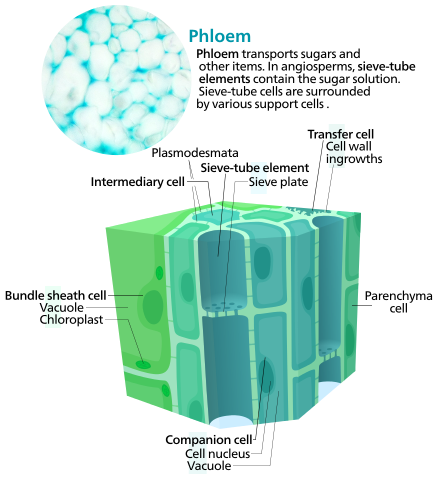
PUMPA - SMART LEARNING
எங்கள் ஆசிரியர்களுடன் 1-ஆன்-1 ஆலோசனை நேரத்தைப் பெறுங்கள். டாப்பர் ஆவதற்கு நாங்கள் பயிற்சி அளிப்போம்
Book Free DemoWe now know that how water and minerals are transported in plants. But what about the products of photosynthesis that are formed in the leaves? How are they transported to the other parts of the plants? Let us discuss it in detail.
The soluble products of photosynthesis are transported to the other parts of the plant by the vascular tissue phloem and its components. This process of transportation is known as the translocation of solutes.
Phloem:

Phloem and its functions
It is the food conducting tissues of the vascular plant. The materials (food), i.e. (towards the root and stem), can move in both directions (bidirectional) because the phloem transports food and water from leaves to all parts of the plant.
Important!
All phloem cells are living except phloem fibres.
The phloem is heterogeneous (complex tissues). It is a permanent tissue composed of different types of elements.
- Sieve elements
- Companion cells
- Phloem fibres
- Phloem parenchyma.

Phloem cells
Sieve elements:
- Conducting elements of phloem are collectively called Sieve elements.
- These are the channels of conduction of food materials in phloem.
- They are the living elements in the phloem with protoplasm.
Sieve tubes:
- The transverse walls at the ends are perforated and are called sieve plates.
- Sieve plates act as the boundaries to sieve areas.
- Sieve tubes are an advanced type of conducting structures in phloem.
- The lack of nuclei and organelles enables a maximum amount of translocation.
- The sieve tubes' primary function is translocation of food from leaves to the plants' storage organs.
Sieve cells:
- These are long, conducting cells in the phloem that do not form sieve tubes.
- The significant difference between sieve cells and sieve-tube members is the lack of sieve plates in sieve cells.
Companion cells:
- The sieve tubes and companion cells are sister cells because they originate from the same mother cell. They function together for the translocation of food.
- They are attached to the sieve tubes' lateral wall.
Phloem parenchyma:
- These are thin-walled cells filled with protoplasm and nucleus, which helps store starch and shows sideways conduction of food.
- It helps to transport organic nutrients from the leaves to the parts of the plant body.
Phloem fibres:
- These are thick-walled sclerenchymatous (dead) cells associated with primary and secondary phloem.
- It is also called Bast fibre or skin fibre.
- It provides mechanical strength to the tissues.
Click here to know more about phloem fibres.
Reference:
https://commons.wikimedia.org/wiki/File:Phloem_cells.svg
https://commons.wikimedia.org/wiki/File:Figure_30_05_06.jpg